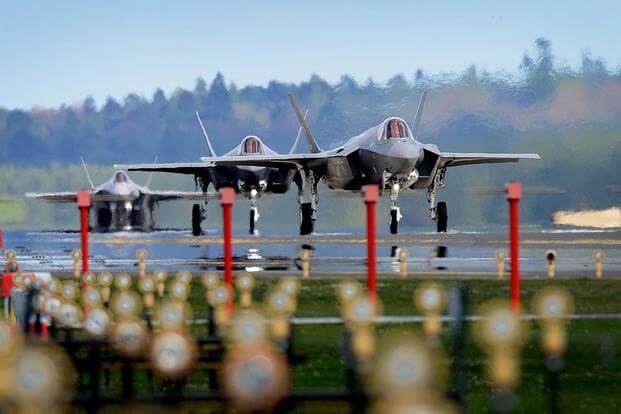Will it cost $1 billion or more just to update the F-35 Joint Strike Fighter every year?
That's the estimate from the F-35's Joint Program Office.
During a House Armed Services tactical air and land forces subcommittee hearing Wednesday, lawmakers were apprehensive about the strategy known as continuous capability development and delivery, or C2D2.
This strategy aims to do smaller, incremental updates instead of taking F-35s off the flightline to get months' worth of larger, packaged software and modernization upgrades needed to "keep up with the latest threats."
Citing a recent report delivered to Congress regarding C2D2, Rep. Niki Tsongas, D-Mass., said costs "may be as high as $11 billion in development and $5.4 billion in procurement" between fiscal 2018 and fiscal 2024 to achieve all the requirements.
Related content:
- Lockheed Negotiating Tactics Delaying F-35 Deal, Program Director Says
- Lockheed Predicts Record-Setting Readiness Rates Soon for F-35
- The F-22 Fighter Jet Restart Is Dead: Study
"This potential cost of $16 billion is an astonishingly high amount and, as far as I am aware, greatly exceeds any cost figures previously provided to Congress," she said.
"It is important to remember this is a software-intensive effort, and the last 17 years of F-35 software development have seen dramatic cost increases and significant delays," Tsongas continued. "If Congress agrees to support this effort at this cost and under the proposed management regime, it should only do so fully aware of the significant risks involved."
Vice Adm. Mat Winter, director of the F-35 Joint Program Office, said the current cost estimate stands at roughly $10.8 billion for development, of which $3.7 billion will be shared by U.S. allies operating the F-35. The Pentagon would thus be responsible for only $7.2 billion over seven years.
Tsongas also queried Air Force, Marine Corps and Navy officials on whether the proposal is reasonable for the fifth-generation stealth jet.
"None of the services have a true comfort level until we have a ... cost of how this is going to happen scoped out," said Lt. Gen. Steven R. Rudder, the Marine Corps' deputy commandant for aviation. "But year by year, we're going to put money into C2D2 at the levels that Admiral Winter is requesting currently."
Rudder testified alongside Winter; Air Force Lt. Gen Jerry D. Harris, deputy chief of staff for Plans, Programs and Requirements; and Rear Adm. Scott D. Conn, air warfare director for the office of the chief of Naval Operations.
Conn agreed with Rudder, and Harris added there are "funds laid in [the Air Force's] plan," as well as plans to reduce sustainment costs long term. He did not specify budget numbers.
C2D2 replaces what was once called Block 4 follow-on modernization, or the succeeding, repetitive mods to Block 4, the latest software modernization to upgrade the F-35's avionics and weapons delivery. Block 4 itself is slated for implementation sometime before the end of 2018.
"We just want to be sure this is rooted in reality," Tsongas said.
In a follow-up discussion with reporters, Winter laid out worst- and best-case cost scenarios.
Going through all of the pre-planning and execution -- when developers and engineers are needed, at what point a certain batch of F-35 Lightning IIs can receive the work, among other factors -- Winter said once those calculations formally come together, $10.8 billion for development is roughly correct.
"That estimate will most likely come down, but I don't guarantee anything," Winter said.
"But we've also looked at, if all of that is correct, what are the modifications to the fleet aircraft, so the procurement elements of this, the software's going to be minuscule," he said, referring to the $5.4 billion figure Tsongas cited.
"If I had all the hardware updates on the first year, it would be a less [of] a procurement cost because all of my new aircraft would already have it in there," Winter said.
In his written prepared testimony for the hearing, Winter cited the Pentagon's lessons learned from upgrading the F-22 Raptor, but did not specify what modifications to the stealth jet have cost. At the Defense Department's order, Lockheed Martin Corp. stopped producing the F-22 in 2011.
"Based on experience from the F-22, an eight-to-10-year span between technology refresh events will maintain viable warfighting capability throughout each cycle," he said in his testimony.
The F-35's total cost has been projected at more than $1 trillion over a 50-year lifetime.
-- Oriana Pawlyk can be reached at oriana.pawlyk@military.com. Follow her on Twitter at @Oriana0214.












